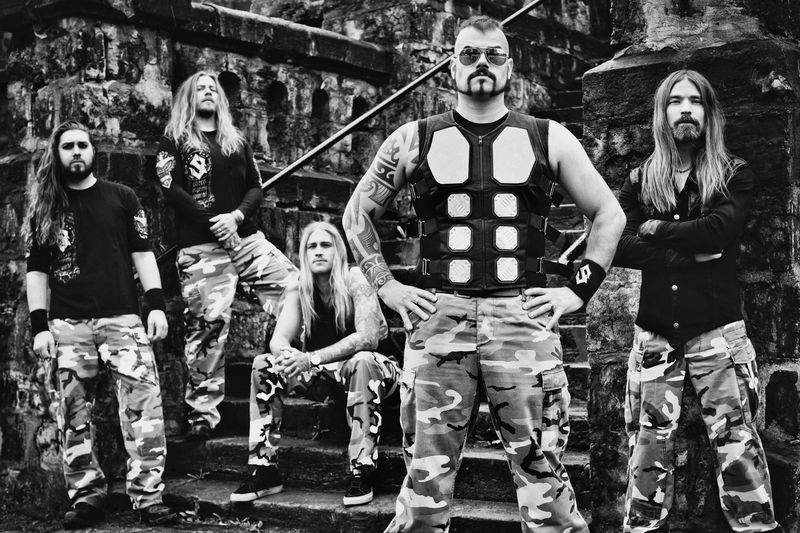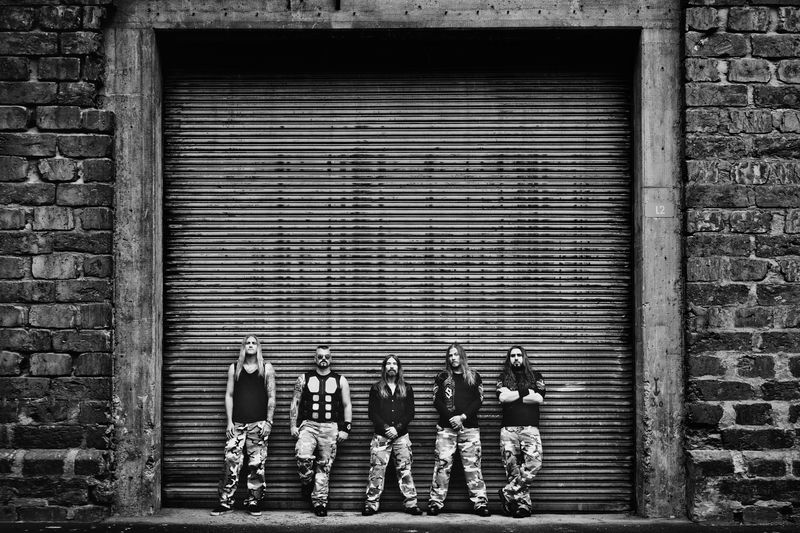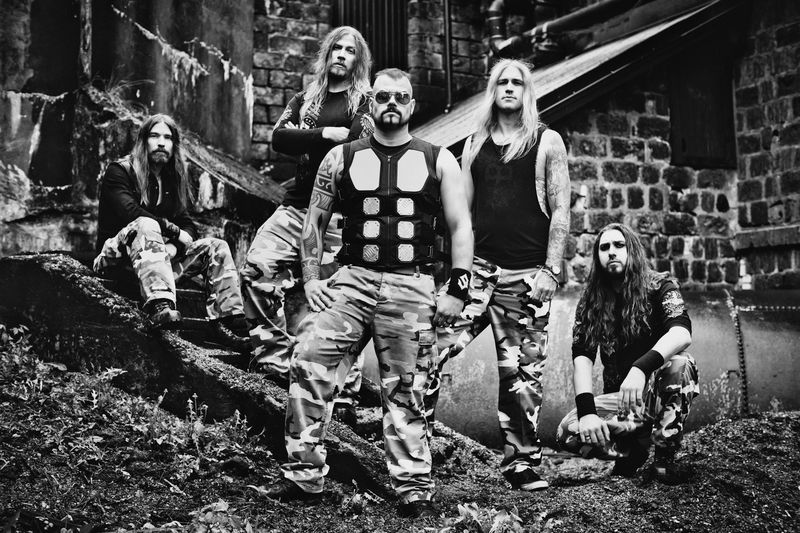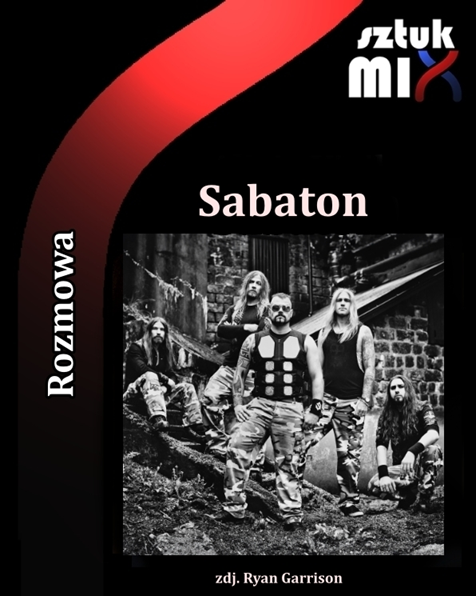English version below/Angielska wersja niżej !!!
Rozmowa z perkusistą zespołu Sabaton – Hannesem Van Dahlem – była niezwykle inspirująca i pełna ciekawych informacji o kulisach pracy grupy. Szczególnym tematem rozmowy był ich najnowszy projekt – film koncertowy „The Tour to End All Tours”, w którym zespół starał się uchwycić nie tylko dźwięk, ale również niesamowite efekty wizualne, takie jak pirotechnika, wyrzutnie ognia czy wspaniała scenografia, które od lat definiują ich widowiskowe koncerty na żywo. Dowiedziałam się także, jak Sabaton dba o historyczną dokładność swoich albumów, współpracując z zewnętrznymi ekspertami, oraz o tym, jak ważne jest dla nich tworzenie muzyki, która nie tylko bawi, ale i edukuje słuchaczy na całym świecie. Poruszyliśmy również kwestię ogromnego sukcesu cyfrowego zespołu, który przekroczył już dwa miliardy odsłuchów, oraz przyszłości, która oprócz premiery filmu, obejmuje współpracę z legendarnym zespołem Judas Priest. Cała rozmowa była pełna pasji i pozytywnej energii, a Hannes potwierdził, że Sabaton to nie tylko zespół, ale prawdziwa muzyczna siła, która pozostaje wierna swoim korzeniom, jednocześnie stale poszukując nowych sposobów na rozwijanie twórczości.
Ula Skowrońska-Malinowska: Głównym powodem, dla którego robimy ten wywiad, jest „Tour to End All Tours” („Trasa, która zakończy wszystkie trasy”)…
Hannes Van Dahl: …Tak, zgadza się.
USM: Została ona opisana jako jedna z największych i najbardziej wybuchowych tras koncertowych Sabatonu. Co było główną motywacją, by zmienić tę konkretną trasę w film?
HVD: Cóż, przede wszystkim, myślę, że to była jedna z tych nocy, kiedy spędziliśmy czas z 16 tysiącami naszych najbliższych holenderskich przyjaciół – zawsze mieliśmy w Holandii świetne koncerty, to bardzo wyjątkowe dla nas miejsce. Było to też kilka tygodni po rozpoczęciu trasy, kiedy wszyscy byli już rozgrzani, bo przecież nie nagrywasz takiego filmu na początku trasy, prawda?

USM: No Jasne, wszyscy muszą się rozkręcić, wejść w rytm.
HVD: Tak, to była największa arena tej trasy. Naturalnie poczuliśmy, że warto to nagrać. Nigdy nie wiesz, co z tego wyjdzie, ale wszyscy, kiedy zeszliśmy ze sceny tej nocy, mieliśmy to uczucie, że to była jedna z tych nocy. Wszystko zagrało: setlista, ekipa, wszystko na tip-top. Myślę, że zagraliśmy naprawdę dobrze. Jestem bardzo zadowolony z efektu końcowego. Byłem bardzo zaangażowany w każdy etap, od miksowania po wideo. A potem, powstało pytanie – gdzie chciałabyś zobaczyć koncert heavy metalowy, jeśli nie możesz być na nim osobiście?
USM: To było moje następne pytanie – kino, prawda?
HVD: Dokładnie! To najbliższe doświadczenie, jakie możesz mieć. Tak więc, wydawało się to naturalnym krokiem, a teraz mogliśmy to zrealizować. Siedzimy tutaj i rozmawiamy, a tysiące kin wyświetli ten film.
USM: Film „Tour to End All Tours” został nakręcony w Ziggo Dome w Amsterdamie, gdzie zagraliście przed 16 000 fanów. Jak specyfika tego miejsca wpłynęła na energię występu? Wspomniałeś już o tym, ale czy chciałbyś coś dodać?
HVD: Tak, myślę, że przy produkcji na takim poziomie miejsce ma znaczenie. To bardzo nowoczesna, nowa arena, więc z pragmatycznych powodów jest to po prostu świetne miejsce. Wygląda dobrze na filmie. A co do energii? To była szalona noc, całość była szalona. Ktoś mnie ostatnio zapytał: „Czy zrobiliście coś specjalnego na ten koncert?” Ale to było po prostu uchwycenie trasy. To był zwykły koncert z tej trasy. Najbardziej teatralna trasa, jaką kiedykolwiek zrobiliśmy, np. na scenie byli aktorzy – to coś nowego dla nas.
USM: Podkreśliłeś immersyjny charakter filmu, prawie tak, jakby fani mogli poczuć, że są na żywo. Jakie były wyzwania techniczne lub kreatywne związane z przeniesieniem energii koncertu na ekran?
HVD: Dobre pytanie. Facet, który reżyserował ten film, Jens De Vos, pracuje z nami od wielu lat. Jest reżyserem i zna nas osobiście, więc wiedział, jak uchwycić to, co chcemy. Widział wiele naszych koncertów i filmował nas wcześniej, więc zaufaliśmy mu, że uchwyci to tak, jak żebyśmy my byli zadowoleni, ale także, by on zrealizował swoją wizję jako reżyser. To było bardzo ważne, a on jest bardzo kreatywną osobą. Uważam, że wykonał świetną robotę. Mieliśmy świetny zespół bardzo kreatywnych ludzi – od naszej ekipy, po ludzi w arenie, po osoby odpowiedzialne za nagrania dźwiękowe, w tym holenderskiego inżyniera, Joosta van den Broeka, który to nagrywał i miksował. To wspólny wysiłek wielu osób.
USM: Dla fanów, którzy widzieli Sabaton na żywo wiele razy, co film zaoferuje im nowego w porównaniu do uczestnictwa w koncercie?
HVD: Masz na myśli, że widzieli nas przed tą trasą? Sabaton to Sabaton, to jest to co robimy. Ale myślę, że to było bardziej angażujące. Staraliśmy się zobaczyć, jak możemy pracować z utworami, aby uczynić występ na żywo lepszym lub wzbogacić znaczenie utworów za pomocą wizualizacji. Element teatralny jest nowy dla nas i myślę, że wyszedł świetnie na tej trasie. Dobrze dobraliśmy też setlistę. To coraz trudniejsze, bo mamy coraz więcej albumów.
USM: Ale przynajmniej jest interesująco.
HVD: Tak, jest to dobry mix nowych i starych utworów. Na przykład graliśmy „Into the Fire”, którego nie graliśmy od lat.
USM: Czy były jakieś momenty w trakcie koncertu, które na ekranie były jeszcze bardziej uderzające niż na żywo?
HVD: Wiesz co, to zależy od tego, jak na to spojrzysz. Na żywo masz tę energię, czujesz ją w swoim ciele. To inne doświadczenie. Ale wizualnie jest kilka momentów, jak kiedy przychodzi czas na „Christmas Truce”, tam dzieje się coś naprawdę wyjątkowego. Ludzie siedzący w pierwszych rzędach mogą nie widzieć całej sceny. W filmie wszystko jest bardziej spójne. Są momenty, które można lepiej uchwycić na filmie…
USM: …W kinie możesz to uchwycić z różnych ujęć i pokazać na ekranie.
HVD: Tak, myślę, że chodzi o to, by stworzyć odpowiedni balans. Ale z drugiej strony, jeśli siedzisz w pierwszym rzędzie na koncercie, czujesz np. bas, czujesz to fizycznie. Myślę, że to zależy, jak na to spojrzeć.

USM: Sabaton jest zespołem znanym z używani na scenie pirotechniki i dużej ilości scenografii.
HVD: Och, było mnóstwo pirotechniki. Myślę, że mieliśmy około 60 miotaczy ognia na scenie, plus maszyny do śniegu, fajerwerki i czołg strzelający płomieniami. To absolutne szaleństwo i wszystko to jest widoczne w filmie.
USM: Brzmi niesamowicie! Więc film jest skierowany do Waszych wiernych fanów, ale także do tych, którzy nie mogli wziąć udziału w koncertach na żywo. Czy to motywuje was do eksplorowania innych sposobów dotarcia do globalnej publiczności, takich jak streaming koncertów?
HVD: Na razie skupiamy się na premierze filmu i na tym, aby ludzie mogli doświadczyć pełnego kinowego wrażenia z dźwiękiem i obrazem. Nie mamy na razie planów dotyczących streamingu, ale kto wie co przyniesie przyszłość. To obecnie niezbędne narzędzie, a jeśli używasz go we właściwy sposób, pozwala ci to na bliskie relacje z fanami. Uważam, że to fajne, kiedy możemy wchodzić w interakcje z ludźmi i słyszeć ich opinie na temat muzyki.
USM: Sabaton porusza w swoich albumach tematy historyczne. Jak podchodzicie do procesu badawczego przy tworzeniu albumów koncepcyjnych? Czy angażujecie zewnętrznych historyków lub ekspertów? I skąd wzięło się zainteresowanie polską historią?
HVD: To świetne pytanie! Nie piszę tekstów, więc to pytanie bardziej dla Joachima, ale z mojego punktu widzenia, to bardzo autentyczne zainteresowanie napędza historyczne tematy. Kiedy dołączyłem do zespołu, nie byłem tak bardzo zainteresowany historią, ale ich pasja udzieliła się także mi. Tak, współpracujemy z zewnętrznymi historykami, aby zapewnić dokładność.
USM: Po dwóch dekadach w branży, co uważasz za klucz do utrzymania energii, kreatywności i relacji z fanami?
HVD: Czerpanie przyjemności z tego, co robimy, jest dużą częścią tego procesu. Ciężka praca jest niezbędna, ale jeśli się dobrze bawisz i pozostajesz pełen pasji, to utrzymuje energię przy życiu.

USM: To zdecydowanie widać! Nie tylko występujecie – angażujecie się w kontakt z fanami, co robi ogromną różnicę.
HVD: Dziękuję, to wielki komplement. Nie mógłbym tego udawać, nawet gdybym chciał. Gram na perkusji każdej nocy i to mnie uszczęśliwia!
USM: A to się udziela! Fani widzą waszą pasję i czerpią z tej energii. Co dalej po premierze filmu „The Tour to End All Tours”? Czy są jakieś nowe utwory lub projekty na horyzoncie?
HVD: Na razie skupiamy się na premierze filmu, która odbędzie się 11 października – to twój dzień urodzin! Wszystkiego najlepszego z tej okazji.
USM: Dziękuję! Fantastyczny prezent urodzinowy!
HVD: Cieszę się, że tak uważasz! Obecnie jesteśmy też w trasie z Judas Priest, co jest niesamowite. To jest legendarne doświadczenie dla nas wszystkich.
USM: No właśnie, jakie to uczucie występować u boku Judas Priest?
HVD: To wydaje się aż nierealne! Wszyscy dorastaliśmy, słuchając ich. Nasz gitarzysta nawet ma tatuaż Judas Priest. Gdyby nie „Painkiller”, nie zacząłbym grać na perkusji. Rozmawianie ze Scottem Travisem, ich perkusistą, i zadawanie mu pytań – to spełnienie marzeń. Wciąż brzmią niesamowicie po 50 latach.
USM: Bardzo dziękuję za wywiad, to była ogromna przyjemność.
HVD: Również dziękuję, że mnie zaprosiłaś i miłego oglądania filmu.
Rozmawiała: Ula Skowrońska Malinowska
English version
An interview with Sabaton’s drummer, Hannes Van Dahl, was incredibly inspiring and full of interesting insights into the band’s behind-the-scenes work. A key topic of the conversation was their latest project – the concert film “The Tour to End All Tours,” where the band aimed to capture not just the sound but also the incredible visual effects, such as pyrotechnics, flame throwers, and stunning stage design that have defined their live shows for years. I also learned how Sabaton ensures the historical accuracy of their albums by working with external experts and how important it is for them to create music that not only entertains but also educates listeners worldwide. We also discussed the band’s huge digital success, with over two billion streams, and the future, which, apart from the film premiere, includes collaboration with the legendary band Judas Priest. The entire conversation was filled with passion and positive energy, and Hannes confirmed that Sabaton is not just a band but a true musical force that remains true to its roots while constantly seeking new ways to evolve creatively.
Ula Skowrońska-Malinowska: The main reason we’re doing this interview is “The Tour to End All Tours”…
Hannes Van Dahl: …Yes, that’s right.
USM: It’s been described as one of the biggest and most explosive Sabaton tours. What was the main motivation to turn this particular tour into a film?
HVD: Well, first of all, I think it was one of those nights when we spent time with 16,000 of our closest Dutch friends—we’ve always had great shows in the Netherlands, it’s a very special place for us. It was also a few weeks into the tour, and everyone was already warmed up, because you don’t record a movie like that at the beginning of a tour, right?

USM: Of course, everyone needs to get into the groove, get into the rhythm.
HVD: Yes, it was the biggest arena of the tour. Naturally, we felt it was worth recording. You never know what will come of it, but when we got off stage that night, we all had the feeling that it was one of those nights. Everything clicked: the setlist, the crew, everything was perfect. I think we played really well. I’m very happy with the final result. I was very involved in every stage, from the mixing to the video. Then, the question arose—where would you like to experience a heavy metal concert if you couldn’t be there in person?
USM: That was going to be my next question—cinema, right?
HVD: Exactly! It’s the closest experience you can have. So, it felt like a natural step, and now we’ve made it happen. We’re sitting here talking, and thousands of cinemas will show this film.
USM: The film “The Tour to End All Tours” was filmed at the Ziggo Dome in Amsterdam, where you played in front of 16,000 fans. How did the uniqueness of that venue influence the energy of the performance? You’ve already touched on it, but would you like to add anything?
HVD: Yes, I think with a production of that scale, the venue matters. It’s a very modern, new arena, so from a practical point of view, it’s just a great place. It looks good on film. And as for the energy? It was a crazy night, the whole thing was wild. Someone recently asked me, “Did you do anything special for that concert?” But it was just capturing the tour. It was a regular show from that tour. It’s the most theatrical tour we’ve ever done, like having actors on stage—that’s something new for us.
USM: You emphasized the immersive nature of the film, almost as if fans could feel like they were at a live show. What were the technical or creative challenges of transferring the concert’s energy to the screen?
HVD: Good question. The guy who directed the film, Jens De Vos, has been working with us for many years. He’s a director and knows us personally, so he knew how to capture what we wanted. He’s seen many of our shows and filmed us before, so we trusted him to capture it in a way that we’d be happy with, while also realizing his vision as a director. That was very important, and he’s a very creative person. I think he did a great job. We had a fantastic team of very creative people—from our crew to the people at the arena to the sound recording folks, including Dutch engineer Joost van den Broek, who recorded and mixed it. It was a collective effort from many people.
USM: For fans who have seen Sabaton live many times, what will the film offer them that’s new compared to attending the concert?
HVD: You mean those who saw us before this tour? Sabaton is Sabaton, that’s what we do. But I think this was more engaging. We tried to work with the songs to make the live performance better or enrich the meaning of the songs with visuals. The theatrical element is new for us, and I think it came across really well on this tour. We also picked a good setlist. It’s getting harder because we have more and more albums.
USM: But at least it keeps things interesting.
HVD: Yes, it’s a good mix of old and new songs. For example, we played “Into the Fire,” which we hadn’t played in years.
USM: Were there any moments during the concert that were even more striking on screen than they were live?
HVD: You know what, it depends on how you look at it. Live, you feel the energy, you feel it in your body. It’s a different experience. But visually, there are a few moments, like during “Christmas Truce,” where something really special happens. People in the front rows might not see the whole stage. In the film, everything is more cohesive. There are moments you can capture better on film…
USM: …In the cinema, you can capture it from different angles and show it on screen.
HVD: Yes, I think it’s about creating the right balance. But on the other hand, if you’re in the front row at a concert, you feel the bass, you feel it physically. I think it depends on how you look at it.

USM: Sabaton is a band known for using pyrotechnics and a lot of stage scenery.
HVD: Oh, there was a ton of pyrotechnics. I think we had about 60 flame throwers on stage, plus snow machines, fireworks, and a tank shooting flames. It was absolute madness, and all of that is visible in the film.
USM: Sounds amazing! So, the film is aimed at your loyal fans but also those who couldn’t attend the live concerts. Does this motivate you to explore other ways of reaching a global audience, like streaming concerts?
HVD: For now, we’re focusing on the film premiere and making sure people can experience the full cinematic experience with sound and visuals. We don’t have any plans for streaming at the moment, but who knows what the future holds. It’s an essential tool now, and if you use it the right way, it allows you to have close relationships with fans. I think it’s cool when we can interact with people and hear their opinions about the music.
USM: Sabaton covers historical topics in its albums. How do you approach the research process when creating concept albums? Do you involve external historians or experts? And where did the interest in Polish history come from?
HVD: That’s a great question! I don’t write the lyrics, so it’s more a question for Joakim, but from my point of view, there’s a very genuine interest driving the historical themes. When I joined the band, I wasn’t as interested in history, but their passion rubbed off on me too. Yes, we work with external historians to ensure accuracy.
USM: After two decades in the industry, what do you think is the key to maintaining energy, creativity, and a connection with fans?
HVD: Enjoying what we do is a big part of the process. Hard work is essential, but if you’re having fun and staying passionate, it keeps the energy alive.

USM: That definitely shows! You’re not just performing—you’re engaging with fans, which makes a huge difference.
HVD: Thank you, that’s a huge compliment. I couldn’t fake it even if I tried. I play drums every night, and that makes me happy!
USM: And that’s contagious! Fans see your passion and feed off that energy. What’s next after the premiere of “The Tour to End All Tours”? Are there any new songs or projects on the horizon?
HVD: For now, we’re focusing on the film premiere, which will take place on October 11—your birthday! Happy birthday, by the way.
USM: Thank you! A fantastic birthday gift!
HVD: I’m glad you think so! We’re also currently touring with Judas Priest, which is amazing. It’s a legendary experience for all of us.
USM: Right, what’s it like to perform alongside Judas Priest?
HVD: It feels almost unreal! We all grew up listening to them. Our guitarist even has a Judas Priest tattoo. If it weren’t for “Painkiller,” I wouldn’t have started playing drums. Talking to Scott Travis, their drummer, and asking him questions—it’s a dream come true. They still sound incredible after 50 years.
USM: Thank you so much for the interview, it’s been an absolute pleasure.
HVD: Thank you as well for invitin
Ula Skowrońska Malinowska
Obserwuj nas w mediach społecznościowych:


